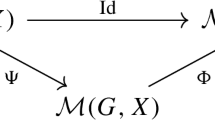Abstract
A Maxwell space is a triple (M, g, F), where M is the four-dimensional Minkowski space or a domain in it, g is a pseudo-Euclidean metric on M, and F is a closed exterior 2-form on M. In this paper, we give an exhaustive description of classes of Maxwell spaces that admit subgroups of the Poincaré group. Representatives of all classes are constructed.
Similar content being viewed by others
References
H. Bacry, P. Combe, and P. Sorba, “Connected subgroups of the Poincaré group, I,” Rep. Math. Phys., 5, No. 2, 145–186 (1974).
H. Bacry, P. Combe, and P. Sorba, “Connected subgroups of the Poincaré group, II, Rep. Math. Phys., 5, No. 3, 361–392 (1974).
I. V. Bel’ko, “Subgroups of the Lorentz-Poincaré group,” Izv. Akad. Nauk Belorus. SSR, 1, 5–13 (1971).
O. G. Belova, A. N. Zarembo, M. A. Parinov, O. O. Sergeeva, and Yu. G. Ugarova, “Classification of static electromagnetic fields over subgroups of the Poincaré group,” Nauch. Tr. Ivan. Univ., Ser. Mat., 3, 11–22 (2000).
A. L. Besse, Einstein Manifolds, Springer-Verlag, Berlin (1987).
P. Combe, and P. Sorba, “Electromagnetic fields with symmetry,” Physica, A80,No. 3, 271–286 (1975).
A. S. Ivanova and M. A. Parinov, “First integrals of Lorentz equations for some classes of electromagnetic fields,” Proc. Steklov Inst. Math., 236, 186–192 (2002).
A. Janner and E. Ascher, “Space-time symmetry of linearly polarized electromagnetic plane waves,” Lett. Nuovo Cim., 2, No. 15, 703–705 (1969).
A. Janner and E. Ascher, “Space-time symmetry of transverse electromagnetic plane waves,” Helv. Phys. Acta, 43, No. 3, 296–303 (1970).
A. Janner and E. Ascher, “Relativistic symmetry groups of uniform electromagnetic fields, Physica, 48, No. 3, 425–446 (1970).
N. A. Kosheleva, A. K. Kuramshina, and M. A. Parinov, “Group classification of Maxwell spaces admitting elliptic helices,” Nauch. Tr. Ivan. Univ., Ser. Mat., 4, 73–82 (2001).
L. D. Landau and E. M. Lifshits, Field Theory [in Russian], Nauka, Moscow (1967).
D. A. L’vov and M. A. Parinov, “Group classification of Maxwell spaces admitting parabolic rotations,” Nauch. Tr. Ivan. Univ., Ser. Mat., 5, 51–62 (2002).
E. G. Morokhova, “Group classification of Maxwell spaces admitting proportional bi-rotations,” Nauch. Tr. Ivan. Univ., Ser. Mat., 5, 63–70 (2002).
E. V. Morozova and M. A. Parinov, “Group classification of Maxwell spaces admitting translations along isotropic straight lines,” Nauch. Tr. Ivan. Univ., Ser. Mat., 4, 87–94 (2001).
M. A. Parinov, “Problem of group classification of electromagnetic fields,” in: Contemporary Methods of Theory of Functions and Related Problems. Voronezh Winter Math. School [in Russian], Voronezh (1999), p. 156.
M. A. Parinov, “Group classification of Maxwell spaces,” in: Contemporary Analysis and Its Applications. Voronezh Winter Math. School [in Russian], Voronezh (2000), pp. 129–130.
M. A. Parinov, “Classes of Maxwell spaces admitting translations,” Sovr. Mat. Prilozh., 10, 157–166 (2003).
M. A. Parinov, Einstein-Maxwell spaces and Lorentz equations [in Russian], Ivanovo (2003).
N. S. Polezhaeva and M. A. Parinov, Group classification of 4-potentials admitting parabolic rotations [in Russian], Preprint, Ivanovo (2003); deposited at the All-Russian Institute for Scientific and Technical Information, Moscow (2003), No. 1489-V2003.
A. I. Vorob’ev, “Group classification of Maxwell spaces admitting hyperbolic helices,” Nauch. Tr. Ivan. Univ., Ser. Mat., 4, 35–42 (2001).
A. I. Vorob’ev, “On the classification of Maxwell spaces admitting hyperbolic helices and first integrals of Lorentz equations,” Sovr. Mat. Prilozh., 10, 39–47 (2003).
A. I. Vorob’ev, “Classification of potential stuctures invariant relative to hyperbolic helices,” Mat. Prilozh. (Ivanovo), 1, 41–50 (2004).
Author information
Authors and Affiliations
Additional information
__________
Translated from Fundamental’naya i Prikladnaya Matematika (Fundamental and Applied Mathematics), Vol. 10, No. 1, Geometry of Integrable Models, 2004.
Rights and permissions
About this article
Cite this article
Parinov, M.A. Classes of Maxwell spaces that admit subgroups of the Poincaré group. J Math Sci 136, 4419–4458 (2006). https://doi.org/10.1007/s10958-006-0235-2
Issue Date:
DOI: https://doi.org/10.1007/s10958-006-0235-2



